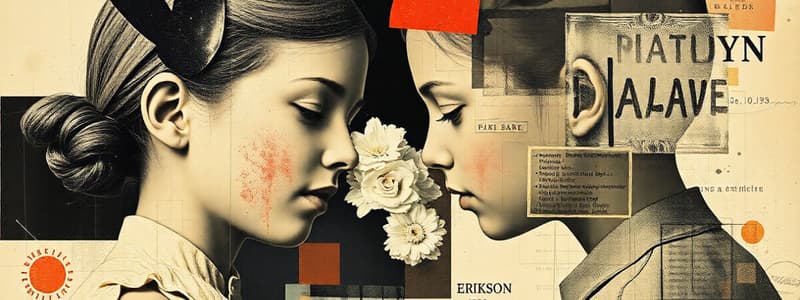Podcast
Questions and Answers
According to Erikson's theory of psychosocial development, during which stage does the development of trust versus mistrust occur?
According to Erikson's theory of psychosocial development, during which stage does the development of trust versus mistrust occur?
- Adolescence
- Early Childhood
- Toddlerhood
- Infancy (correct)
If an infant consistently experiences neglect and unmet needs, which of Erikson's psychosocial stages are they most likely to struggle with?
If an infant consistently experiences neglect and unmet needs, which of Erikson's psychosocial stages are they most likely to struggle with?
- Initiative vs. Guilt
- Autonomy vs. Shame and Doubt
- Trust vs. Mistrust (correct)
- Industry vs. Inferiority
The 'rouge test' is used to assess which aspect of development in infants?
The 'rouge test' is used to assess which aspect of development in infants?
- Motor skills
- Attachment style
- Sense of self (correct)
- Object permanence
An 18-month-old child looks in the mirror and touches a mark on their nose. According to developmental psychology, what does this behavior likely indicate?
An 18-month-old child looks in the mirror and touches a mark on their nose. According to developmental psychology, what does this behavior likely indicate?
A child who does NOT recognize themselves in the mirror during the rouge test might be lacking in what developmental aspect?
A child who does NOT recognize themselves in the mirror during the rouge test might be lacking in what developmental aspect?
At what age do infants typically begin to demonstrate self-recognition, as indicated by the rouge test?
At what age do infants typically begin to demonstrate self-recognition, as indicated by the rouge test?
According to Erikson, successfully navigating the trust vs. mistrust stage in infancy results in what outcome?
According to Erikson, successfully navigating the trust vs. mistrust stage in infancy results in what outcome?
What is the primary focus of social development during the first year of life, according to Erik Erikson?
What is the primary focus of social development during the first year of life, according to Erik Erikson?
Failure to resolve the trust vs. mistrust stage can lead to which of the following in later development?
Failure to resolve the trust vs. mistrust stage can lead to which of the following in later development?
Which behavior would suggest that a 20-month-old child has developed a sense of self?
Which behavior would suggest that a 20-month-old child has developed a sense of self?
What environmental factor is MOST crucial for an infant developing a sense of trust, according to Erikson?
What environmental factor is MOST crucial for an infant developing a sense of trust, according to Erikson?
In the context of the rouge test, if an infant touches the mirror instead of their own nose, what does this indicate about their sense of self?
In the context of the rouge test, if an infant touches the mirror instead of their own nose, what does this indicate about their sense of self?
Which behavior would indicate a secure and comfortable environment, leading to the development of trust in infants, according to Erikson?
Which behavior would indicate a secure and comfortable environment, leading to the development of trust in infants, according to Erikson?
How does the development of a sense of self typically manifest in infants around 18-24 months old?
How does the development of a sense of self typically manifest in infants around 18-24 months old?
According to Erikson, what is a potential long-term consequence of an infant experiencing prolonged mistrust?
According to Erikson, what is a potential long-term consequence of an infant experiencing prolonged mistrust?
The rouge test primarily evaluates an infant's awareness of:
The rouge test primarily evaluates an infant's awareness of:
Consistent parental responsiveness to an infant's needs is MOST likely to result in:
Consistent parental responsiveness to an infant's needs is MOST likely to result in:
According to Erikson's psychosocial theory, what is the central question infants grapple with during their first year of life?
According to Erikson's psychosocial theory, what is the central question infants grapple with during their first year of life?
A child who avoids looking at themselves in a mirror during the rouge test might be demonstrating:
A child who avoids looking at themselves in a mirror during the rouge test might be demonstrating:
Which of the following is a primary characteristic of Erikson's stage of Trust vs. Mistrust?
Which of the following is a primary characteristic of Erikson's stage of Trust vs. Mistrust?
According to Erikson's theory, the successful resolution of the trust versus mistrust stage in infancy leads to a child who is more likely to be:
According to Erikson's theory, the successful resolution of the trust versus mistrust stage in infancy leads to a child who is more likely to be:
If a toddler is given the rouge test and they touch the mark on the mirror rather than their own face, what does this suggest about their development?
If a toddler is given the rouge test and they touch the mark on the mirror rather than their own face, what does this suggest about their development?
In Erikson's psychosocial theory, what is the negative outcome of the first stage, trust versus mistrust?
In Erikson's psychosocial theory, what is the negative outcome of the first stage, trust versus mistrust?
A caregiver who is inconsistent and neglectful towards an infant might contribute to the infant developing:
A caregiver who is inconsistent and neglectful towards an infant might contribute to the infant developing:
What is the significance of the rouge test in assessing socioemotional development in infancy?
What is the significance of the rouge test in assessing socioemotional development in infancy?
According to Erikson's theory, what is the result of successfully resolving the crisis of trust vs. mistrust in infancy?
According to Erikson's theory, what is the result of successfully resolving the crisis of trust vs. mistrust in infancy?
Which of the following is the MOST likely age when an infant starts showing a sense of self, as measured by the rouge test?
Which of the following is the MOST likely age when an infant starts showing a sense of self, as measured by the rouge test?
According to Erikson, infants who do not have a secure and comfortable environment are likely to:
According to Erikson, infants who do not have a secure and comfortable environment are likely to:
During which timeframe do infants develop a sense of self, as evidenced by the rouge test?
During which timeframe do infants develop a sense of self, as evidenced by the rouge test?
If an infant does not touch their nose in the mirror during the rouge test, instead touching the mirror, it indicates:
If an infant does not touch their nose in the mirror during the rouge test, instead touching the mirror, it indicates:
According to Erikson, what is the MOST important factor in determining whether an infant develops trust or mistrust?
According to Erikson, what is the MOST important factor in determining whether an infant develops trust or mistrust?
Considering the information provided, which research method is used to assess the development of self-recognition in infants?
Considering the information provided, which research method is used to assess the development of self-recognition in infants?
If a child shows distress when viewing themselves in a mirror with a mark on their face and tries to rub the mark off, this indicates they have developed?
If a child shows distress when viewing themselves in a mirror with a mark on their face and tries to rub the mark off, this indicates they have developed?
What specific behavior during the rouge test suggests that a child has NOT yet developed a sense of self-recognition?
What specific behavior during the rouge test suggests that a child has NOT yet developed a sense of self-recognition?
According to Erikson, what is likely to result from consistent and reliable caregiving?
According to Erikson, what is likely to result from consistent and reliable caregiving?
What does the rouge test primarily measure in infants?
What does the rouge test primarily measure in infants?
If an infant consistently has their needs met and feels secure, Erikson's theory suggests they will develop:
If an infant consistently has their needs met and feels secure, Erikson's theory suggests they will develop:
What is one of the key indicators that a child has developed self-recognition?
What is one of the key indicators that a child has developed self-recognition?
In relation to the rouge test, a child who points at the mark on their face in the mirror, rather than attempting to touch their own face, indicates:
In relation to the rouge test, a child who points at the mark on their face in the mirror, rather than attempting to touch their own face, indicates:
What is the MOST likely age for a child to begin showing signs of self-recognition as measured by the 'rouge test'?
What is the MOST likely age for a child to begin showing signs of self-recognition as measured by the 'rouge test'?
Flashcards
Trust vs. Mistrust
Trust vs. Mistrust
Erikson's first stage, occurring in the first year of life, where infants develop trust if their needs are met consistently.
Rouge Test
Rouge Test
A test where a mark is placed on the infant's face and they are placed in front of a mirror to see if they recognize themselves.
Sense of Self
Sense of Self
The understanding that one exists as an individual, separate from others.
Study Notes
- Socioemotional development occurs during infancy.
Erikson's Social Development Stages
- Trust versus mistrust is the first stage, occurring during the first year.
- Infants in secure and comfortable environments develop trust.
- Inadequate environments can lead to persistent trust issues.
Developing Sense of Self
- A sense of self as an individual typically develops around 18-24 months.
Rouge Test
- The rouge test involves placing something on a baby’s nose and having them look in a mirror.
- Touching the mirror suggests the baby does not yet have a sense of self.
Studying That Suits You
Use AI to generate personalized quizzes and flashcards to suit your learning preferences.




